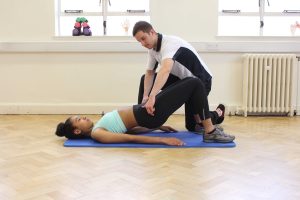Back injuries from lifting are a prevalent concern for weightlifters, fitness enthusiasts, and anyone who regularly lifts heavy objects. Whether you’re lifting at the gym or picking up heavy boxes at work, improper technique or overexertion can lead to serious back pain and long-term damage. Understanding the different types of back injuries, their causes, and …
Back Injuries from Lifting: Prevention, Types, and Treatment Options

Back injuries from lifting are a prevalent concern for weightlifters, fitness enthusiasts, and anyone who regularly lifts heavy objects. Whether you’re lifting at the gym or picking up heavy boxes at work, improper technique or overexertion can lead to serious back pain and long-term damage. Understanding the different types of back injuries, their causes, and prevention strategies can help you stay safe and avoid setbacks. This comprehensive guide will delve into common types of back injuries from lifting, causes, prevention techniques, and the best lifting injuries treatment options to ensure a healthy and injury-free back.
Understanding Back Injuries from Lifting
Back injuries from lifting, particularly low back pain (LBP), are a major concern for individuals who engage in strength-based activities like weightlifting. Low back pain is one of the most common musculoskeletal disorders and has the highest global prevalence among such conditions. It is also the leading cause of disability worldwide. Whether you are a casual gym-goer or an experienced weightlifter, the strain of lifting heavy weights without proper form can significantly impact the lower back, leading to discomfort or long-term pain.
Common Types of Back Injuries from Lifting
Understanding the common types of back injuries from lifting is essential for anyone involved in weightlifting or physically demanding activities. These injuries can vary in severity and impact, but identifying them early can help prevent long-term issues. From lumbar strains to herniated discs, each type of injury requires specific attention and treatment for optimal recovery.
Lumbar Strain
One of the most prevalent types of back injuries, particularly for weightlifters, is lumbar strain. Weightlifting, which involves lifting heavy weights to activate various muscle groups, can cause significant stress on the lower back. If lifting techniques are incorrect, it can lead to overstretching or tearing of the muscles and tendons in the lumbar area. As a result, weightlifters are more prone to experiencing lumbar strain, which can lead to LBP and hinder training progress.
Herniated Disc
A herniated disc occurs when the soft center of an intervertebral disc bulges out or ruptures, pressing on nearby nerves. This type of back injury is often caused by improper lifting, especially when lifting heavy loads with poor posture or sudden twisting motions. Risk factors for disc herniation include weak core muscles, previous back injuries, or lifting heavy weights with uneven weight distribution. Prevention strategies include using a weightlifting belt, maintaining good posture, and strengthening the core muscles. If left untreated, a herniated disc can lead to more serious complications like sciatica or numbness down the legs, requiring treatments such as physical therapy, spinal injections, or minimally invasive surgery.
Sprains and Strains
Sprains and strains are common injuries resulting from improper lifting techniques. Sprains refer to ligament injuries, while strains involve muscle or tendon injuries. Improper body mechanics—like twisting the spine or lifting with a bent back—can cause these injuries. The muscles or ligaments can overstretch, leading to inflammation, pain, and swelling. If you experience symptoms such as muscle spasms or difficulty moving, it’s important to rest and apply ice. For more serious injuries, a healthcare provider may recommend physical therapy or even imaging studies like X-rays or CT scans to rule out any severe internal damage.
Spondylolysis
Spondylolysis is a stress fracture in the spine, commonly seen in athletes who engage in weightlifting or high-impact sports. It occurs when repetitive stress weakens the bones of the vertebrae, leading to cracks or fractures. Lifting heavy weights with improper form or without sufficient core strength can increase the risk of developing spondylolysis. Symptoms often include localized pain in the lower back, especially during physical activity. Long-term management involves strengthening the lower back muscles, avoiding high-stress movements, and in severe cases, surgical intervention like a laminectomy or minimally invasive discectomy.
Causes of Back Injuries When Lifting Heavy Objects

Understanding the causes of back injuries when lifting heavy objects can help you avoid making common mistakes. From poor posture to lifting with improper technique, these factors contribute significantly to the risk of injury.
Several factors contribute to back injuries from lifting heavy objects:
- Poor lifting posture and technique: Incorrect lifting posture, such as bending at the waist or twisting the spine while lifting, can place unnecessary strain on the lower back. This increases the risk of muscle strains, ligament sprains, and even herniated discs.
- Sudden, heavy loads and improper body mechanics: Lifting a load that’s too heavy for your body can lead to muscle strain and injury. Additionally, lifting with improper mechanics, like uneven weight distribution, can increase the risk of back injuries.
- Lack of warm-up or strength imbalance: A proper warm-up and stretching routine can help prepare your muscles for lifting. Weak or imbalanced core muscles are more prone to injury when lifting heavy objects. Strengthening the core and back muscles is critical for injury prevention.
- Repetitive stress and muscle fatigue: Engaging in repetitive lifting without proper rest or recovery can cause muscle fatigue, leading to strains and sprains. This is particularly common in individuals who frequently lift heavy objects or perform high-impact exercises without adequate recovery periods.
Lower Back Pain After Lifting Something Heavy: What You Need to Know
It’s not uncommon to experience lower back pain after lifting something heavy, even if you follow the correct lifting techniques. However, understanding whether the pain is due to a mild strain or a more serious injury is crucial. If the pain is mild, rest and gentle stretching may be enough for recovery. However, if you experience symptoms like numbness, muscle cramping, or sciatica, it could indicate a more severe injury, such as a herniated disc. Seeking medical advice is essential to ensure a proper diagnosis and treatment plan.
When to Seek Medical Help for Lower Back Pain
If you experience persistent pain or any red flags such as loss of bladder control, numbness down the legs, or difficulty moving, it’s important to consult with a healthcare provider. A physical examination, along with diagnostic tests like X-rays or CT scans, can help determine the extent of the injury. Based on the findings, treatments may include physical therapy, anti-inflammatory medications, or in some cases, surgical interventions like a minimally invasive discectomy.
How to Prevent Back Injuries from Lifting
Preventing common back injuries from lifting is essential to long-term fitness and performance. Correct form, warm-up exercises, and strengthening routines all play a crucial role in protecting your back.
Correct Lifting Techniques for a Healthy Back
Proper lifting techniques are essential for protecting your back from injury. Always bend at your knees, not your waist, when lifting heavy objects. Keep the object close to your body and avoid twisting the spine. Align your shoulders and hips, and make sure to stabilize the lower back before lifting. Using protective equipment like weightlifting belts can help support the lower back when lifting heavy loads.
Building Back Strength and Flexibility
A strong and flexible back is less prone to injury. Strengthen your core muscles by performing exercises like planks, deadlifts, and squats. Stretching exercises, such as yoga or Pilates, can improve flexibility and prevent back stiffness. Strong leg muscles also support the back, helping to distribute the weight evenly during lifts and reducing the risk of strain.
The Role of Core Stability in Protecting Your Back
Core strength plays a critical role in protecting your lower back. A weak core puts additional strain on the spine during lifting. Incorporating core exercises such as bridges and abdominal crunches into your routine will help stabilize your back and reduce the risk of injury. Tai Chi and yoga are also excellent ways to improve core strength and flexibility, providing an extra layer of protection when lifting.
Treatment and Recovery for Back Injuries from Lifting
Recovering from back injuries requires prompt treatment and a comprehensive recovery plan. Whether it’s a mild muscle strain or a more severe herniated disc, addressing the injury effectively is crucial for long-term health.
At Sustain Physical Therapy and Performance, we specialize in helping individuals recover from back injuries from lifting through personalized, evidence-based treatment plans. Whether you’re dealing with lumbar strain, herniated discs, or chronic lower back pain, our expert team uses cutting-edge rehabilitation techniques to restore strength, mobility, and function. We focus on correcting improper lifting techniques, addressing core muscle imbalances, and implementing targeted physical therapy to prevent future injuries. With a commitment to non-surgical spine care and performance optimization, we help lifters, athletes, and active individuals get back to peak performance safely and effectively.
Immediate Care for Back Strains and Sprains

For acute back injuries, apply the R.I.C.E. method (Rest, Ice, Compression, Elevation) immediately. Anti-inflammatory medications can help reduce swelling and pain, while physical therapy can assist with rehabilitation. If the injury is severe, imaging studies such as MRIs or X-rays may be necessary to assess the extent of the damage.
Physical Therapy and Rehabilitation
A physical therapist can design a rehabilitation program tailored to your specific injury, helping to restore strength, flexibility, and mobility in the back muscles. Back pain treatments often include exercises to strengthen the core and lower back muscles, which will help prevent future injuries.
Surgical Options for Severe Back Injuries
In cases of severe back injuries, such as herniated discs or fractures, surgery may be necessary. Minimally invasive options like a minimally invasive discectomy can remove damaged tissue without requiring a large incision. Recovery from surgery typically takes several months and involves physical therapy to regain strength and function.
Tips for Avoiding Future Back Injuries
Preventing future back injuries is a priority for those who lift regularly. By adopting safe lifting practices and incorporating strength-building exercises, you can significantly reduce the risk of re-injury.
- Gradually increase the weight you lift to avoid overloading your back and causing injury.
- Incorporate regular stretching and warm-up routines to prepare your body for lifting.
- Adjust your lifting routine based on previous injuries to avoid further strain on your back.
Conclusion
Back injuries from lifting are common but preventable. By using proper lifting techniques, strengthening the core, and ensuring good posture, you can significantly reduce your risk of injury. Should an injury occur, seeking early treatment can help you recover quickly and safely return to your routine. Be proactive in your approach to lifting, and your back will thank you for it.
FAQs
What is the most common back injury from lifting?
The most common injury is lumbar strain, which occurs when the muscles or tendons in the lower back are overstretched or torn due to improper lifting.
How do you fix a back injury from lifting?
Treatment for a back injury typically includes rest, ice, compression, and elevation (R.I.C.E.). For more severe injuries, physical therapy, medications, or surgery may be required.
How long does a back injury from lifting take to heal?
The healing time depends on the severity of the injury. Mild strains may heal in a few weeks, while more serious injuries like herniated discs may take several months of treatment and rehabilitation.
Dr. Adam Babcock PT, DPT
“We Help Active Adults Quickly Recover From Pain Or Injury So They Can Stay Active, Get Back To What They Love To Do, and Do It For Decades”






